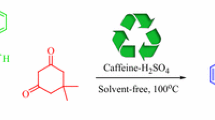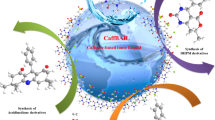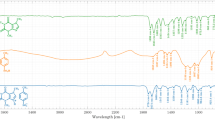Abstract
Caffeine-H3PO4 along with caffeine-HClO4 and caffeine-HNO3 have been prepared and applied for one-pot preparation of bis(indolyl) methanes, 4,4′-(arylmethylene) bis(1H-pyrazol-5-ols), 3,3′-(arylmethylene) bis(4-hydroxycoumarins), 2,4,5-trisubstituted imidazoles, 1‐amidoalkyl‐2‐naphthols, and polyhydroquinolines. The catalysts were characterized using Fourier-transform infrared (FTIR) spectroscopy, 1H and 13C nuclear magnetic resonance (NMR), powder X-ray diffraction (PXRD) analysis, thermogravimetric analysis (TGA), and liquid chromatography (LC)–mass spectroscopy (MS) techniques. The results indicated high product yield, short reaction time, facile separation of catalyst, and easy work-up procedure, suggesting that caffeine-H3PO4 can be considered to be an efficient acidic catalyst for organic transformations.
Similar content being viewed by others
Explore related subjects
Discover the latest articles, news and stories from top researchers in related subjects.Avoid common mistakes on your manuscript.
Introduction
The design of novel catalysts for particular tasks has attracted attention due to industrial needs for higher product yield and/or purity in shorter reaction time [1, 2]. Meanwhile, research on preparation of novel acidic catalysts such as ionic liquids [3], zeolites [4], metal–organic frameworks (MOFs) [5], and organocatalysts [6] has drawn attention recently.
Multicomponent reactions (MCRs) have been a focus of interest for organic and medicinal chemists recently, due to the simplicity and diversity they offer [7, 8]. Apart from their applications in synthesis, MCRs have also been applied as criteria for benchmarking novel catalysts, including acidic [9], basic [10], magnetic nanoparticle-supported [11], SBA-15-supported [12], and MOF-supported materials [13], as well as ionic liquids [14].
Solvent-free organic reactions have been proposed as a solution to environmental concerns regarding use of organic solvents [15]. Solvent-free multicomponent synthesis enables organic and medicinal chemists to prepare biologically active scaffolds that are traditionally synthesized using a sequence of separate reaction steps. The synergism of performing multicomponent reactions under solvent-free conditions would be considered beneficial due to the simple monitoring of the reaction, ability to perform the reaction at any temperature due to the absence of solvent, simple reaction setup, and easy workup [16].
In continuation of our previous work on applications of novel catalysts in organic synthesis [17, 18], we decided to investigate one-pot preparation of bis(indolyl) methanes, 4,4′-(arylmethylene) bis(1H-pyrazol-5-ols), 3,3′-(arylmethylene) bis(4-hydroxycoumarins), 2,4,5-trisubstituted imidazoles, 1‐amidoalkyl‐2‐naphthols, and polyhydroquinolines in presence of catalytic amount of caffeine-H3PO4 under solvent-free conditions (Scheme 1).
Results and discussion
In the first step, caffeine-H3PO4, caffeine-HClO4, and caffeine-HNO3 were prepared by dropwise addition of concentrated phosphoric acid, perchloric acid, and nitric acid, respectively, to solution of caffeine in CHCl3. The mixture was stirred overnight, and the precipitate was filtered and washed with acetone (Scheme 2). The catalysts were characterized by FTIR spectroscopy. The characteristic peaks of caffeine due to amide functional groups at 1654 and 1697 cm−1 were apparent in the spectra, with a slight shift to higher wavenumber (Figs. 1, 2, 3).
The thermal stability of the catalysts was evaluated by thermogravimetric analysis (TGA). Degradation of caffeine-H3PO4, caffeine-HClO4, and caffeine-HNO3 was observed to start at 268, 306, and 250 °C.
To confirm that the caffeine molecule remained intact, 13C NMR of caffeine-H3PO4 was carried out, revealing the characteristic peaks in the spectrum (Fig. S1).
In the LC–MS spectrum, the caffeine-H+ peak was seen at m/z of 194.9 (100 %) and 195.9 (11.4 %).
Finally the powder X-ray diffraction (XRD) patterns of caffeine and caffeine-H3PO4 were recorded (Fig. 4).
After successful characterization of caffeine-H3PO4, caffeine-HClO4, and caffeine-HNO3, it was decided to utilize these catalysts for synthesis in various one-pot organic reactions.
First, preparation of polyhydroquinoline via reaction of benzaldehyde (1 mmol), dimedone (1 mmol), ethyl acetoacetate (1 mmol), and NH4OAc (1.5 mmol) in presence of caffeine-H3PO4, caffeine-HClO4, and caffeine-HNO3 was utilized to benchmark the catalysts. The catalytic activity of caffeine-H3PO4 was superior compared with the other catalysts. It appears that caffeine-HClO4 and caffeine-HNO3, which have a nonacidic counterion, did not show good catalytic activity. In contrast, caffeine-H3PO4, which has an acidic counterion, showed excellent acidic activity. Thus, considering that the catalyst remained intact in the reaction medium, it seems that caffeine-HClO4 and caffeine-HNO3 act as organocatalysts via the caffeine-H+ core. On the other hand, caffeine-H3PO4, which has an acidic counterion, can act as both an organocatalyst and Brønsted acid. These synergistic effects make caffeine-H3PO4 the preferred catalyst. The optimized condition was found to be reaction temperature of 100 °C and amount of catalyst of 7.5 mol%. Increasing the amount of catalyst or temperature neither increased the yield nor shortened the time substantially (Table 1). Therefore, with the optimized reaction condition in hand, we explored the efficiency of caffeine-H3PO4 for one-pot preparation of polyhydroquinoline derivatives via Hantzsch condensation (Table 2).
After this successful preparation of polyhydroquinoline derivatives using the catalyst, it was decided to explore its activity in one-pot preparation of 1-amidoalkyl-2-naphthols. The results are summarized in Table 3.
Using the same method as mentioned above, the catalytic activity of caffeine-H3PO4 was also evaluated in one-pot synthesis of 2,4,5-trisubstituted imidazoles, showing satisfactory results (Table 4).
For the last set of reactions to assess the catalyst’s activity, we selected one-pot preparation of bis(indolyl) methanes (Table 5), 4,4′-(arylmethylene) bis(1H-pyrazol-5-ols) (Table 6), and 3,3′-(arylmethylene) bis(4-hydroxycoumarins) (Table 7). The optimum reaction temperature was found to be 80 °C. The corresponding products were prepared in presence of caffeine-H3PO4.
Given the increasing regard being paid to green chemistry, we decided to study the recyclability and reusability of the catalyst in preparation of 3,3′-(arylmethylene) bis(4-hydroxycoumarins). After completion of the reaction, water was evaporated and the catalyst was reused for four subsequent cycles. A small decrease in performance of the catalyst was observed in subsequent cycles (Fig. 5).
To confirm the intactness of the catalyst, the FTIR spectrum of caffeine-H3PO4 was recorded (Fig. 6). The catalyst did not change during the course of the reaction. Thus, caffeine-H3PO4 can be considered to be an efficient recyclable green catalyst for organic synthesis.
To identify the advantages of using caffeine-H3PO4 compared with reported catalysts, the model reaction of aromatic aldehydes, dimedone, ethyl acetoacetate, and NH4OAc for preparation of polyhydroquinolines was considered as a representative example (Table 8). Compared with the caffeine-H3PO4-catalyzed procedure, some of the reported procedures required prolonged reaction time (entries 1, 2, 5) or gave lower product yield (entries 1, 2, 4, 5). These results obviously demonstrate that caffeine-H3PO4 could be used as a novel catalyst for organic transformations.
Experimental
General
All commercially available chemicals were purchased from Sigma and Merck companies and used without further purification. Products were characterized based on their physical constants and comparison with authentic samples. Reaction monitoring was carried out by TLC on silica gel POLYGRAM SIL G/UV254 plates. FTIR spectra were recorded on a BOMEM MB-Series 1998 spectrophotometer using KBr pellets as samples in the range of 4000 to 400 cm−1. 1H and 13C NMR spectra were recorded in dimethylsulfoxide (DMSO)-d 6 on a Bruker 250 MHz spectrometer using tetramethylsilane (TMS) as internal standard. The thermal stability of the supported catalyst was examined using a BÄHR SPA 503 thermogravimetric analyzer at heating rate of 10 °C min−1 over the temperature range of 40–600 °C under nitrogen atmosphere. The LC-MS spectrum was recorded using an Agilent 6410 triple-quadrupole LC/MS.
General procedure for preparation of caffeine-H 3 PO 4 , caffeine-HClO 4 , and caffeine-HNO 3
In a 25-mL round-bottomed flask, caffeine (1.94 g, 10 mmol) was dissolved in 20 mL CHCl3, and the solution was stirred for 1 h. Concentrated phosphoric/perchloric/nitric acid (10 mmol) was added to the flask. The mixture was stirred overnight at room temperature. The precipitate was centrifuged and washed several times with CHCl3 and finally with acetone. Finally, white solid powder (caffeine-H3PO4, caffeine-HClO4, or caffeine-HNO3) was obtained and dried at 60 °C for 12 h.
Spectra of catalysts
Caffeine-H3PO4, white powder, M.P. 138 °C, IR (KBr, cm−1): 3171, 2960, 2857, 2360, 1717, 1666, 985, 745, 484; 1H NMR (250 MHz, DMSO-d6): δ (ppm) 3.12 (s, 3H, CH3), 3.31 (s, 3H, CH3), 3.79 (s, 3H, CH3), 7.8 (s, 1H, ArH), 9.1 (s, 3H, H3PO4); 13C NMR (62.5 MHz, DMSO-d6): δ (ppm) 155.2, 151.72, 148.7, 143.4, 107.3, 33.8, 30.1, 28.2; LC-MS (ESI, positive mode) m/z (%): 194.9 (M+, 100), 195.9 (M+1+, 11).
Caffeine-HNO3, white powder, M.P. 145 °C (color change to orange), IR (KBr, cm−1): 3083, 2958, 2344, 1726, 1688, 1549, 1406, 1390, 1110, 763, 623; 1H NMR (250 MHz, DMSO-d6): δ (ppm) 3.11 (s, 3H, CH3), 3.31 (s, 3H, CH3), 3.79 (s, 3H, CH3), 7.94 (s, 1H, ArH), 11.85 (s, 1H, HNO3); 13C NMR (62.5 MHz, DMSO-d6): δ (ppm) 155.8, 152.4, 149.2, 144.0, 107.9, 34.5, 30.8, 28.8; LC-MS (ESI, positive mode) m/z (%): 194.9 (M+, 100), 195.9 (M+1+, 11).
Caffeine-HClO4, white powder, M.P. >150 °C, IR (KBr, cm−1): 3165, 3076, 2960, 2890, 1723, 1680, 1646, 1540, 1448, 1100, 763, 622; 1H NMR (250 MHz, DMSO-d6): δ (ppm) 3.15 (s, 3H, CH3), 3.35 (s, 3H, CH3), 3.82 (s, 3H, CH3), 6.43 (s, 1H, HClO4), 7.95 (s, 1H, ArH); 13C NMR (62.5 MHz, DMSO-d6): δ (ppm) 155.9, 152.4, 149.4, 144.1, 107.9, 34.6, 30.8, 28.9; LC-MS (ESI, positive mode) m/z (%): 194.9 (M+, 100), 195.9 (M+1+, 11).
General procedure for preparation of polyhydroquinolines
Mixture of dimedone (0.14 g, 1 mmol), ethyl acetoacetate (0.13 g, 1 mmol), aromatic aldehydes (1 mmol), ammonium acetate (0.115, 1.5 mmol), and caffeine-H3PO4 (0.022 g, 7.5 mol%) was heated at 100 °C. Reaction completion was indicated by TLC [EtOAc/n-hexane (3:10)], after which the mixture was washed with water and the crude product was recrystallized in hot ethanol to afford the pure product.
2,7,7-Trimethyl-5-oxo-4-thiophen-2-yl-1,4,5,6,7,8-hexahydroquinoline-3-carboxylic acid ethyl ester (11a)
1H NMR (DMSO-d6, 250 MHz): δ 0.92 (s, 3H), 0.99 (s, 3H), 1.16 (t, J = 7 Hz, 3H, -OCH2CH 3), 2.12 (dd, J = 22 Hz, 2H), 2.27 (s, 3H), 2.41 (dd, J = 15 Hz, 2H), 4.04 (q, J = 7 Hz, 2H, -OCH 2CH3), 5.18 (s, 1H), 6.65–7.14 (m, 3H, thiophene), 9.23 (s, 1H); 13C NMR (DMSO-d6, 62.5 MHz): δ 194.7, 167.1, 152, 150.3, 145.9, 126.7, 123.7, 123, 109.9, 103.5, 59.6, 50.6, 32.5, 31, 29.6, 27, 18.7, 14.7.
General procedure for preparation of 2,4,5-trisubstituted imidazoles
Mixture of benzil (0.21 g, 1 mmol), aromatic aldehydes (1 mmol), ammonium acetate (0.19 g, 2.5 mmol), and caffeine-H3PO4 (0.022 g, 7.5 mol%) was heated at 120 °C. Reaction completion was indicated by TLC [EtOAc/n-hexane (3:10)], after which the mixture was washed with water and the crude product was recrystallized in hot ethanol to afford the pure product.
4,5-Diphenyl-2-(thiophen-2-yl)-1 H -imidazole (11c)
1H NMR (DMSO-d6, 250 MHz): δ 7.11–8.64 (m, 13H, ArH), 12.76 (s, 1H, NH); 13C NMR (DMSO-d6, 62.5 MHz): δ 192.2, 142, 137.6, 135.9, 134.4, 131.3, 130, 129.9, 128.9, 128.6, 128.3, 127.5, 126.7, 124.7, 124.5.
General procedure for preparation of 1‐amidoalkyl‐2‐naphthols
Mixture of β-naphthol (0.14 g, 1 mmol), aromatic aldehydes (1 mmol), acetamide (0.09 g, 1.5 mmol), and caffeine-H3PO4 (0.022 g, 7.5 mol%) was heated at 100 °C. Reaction completion was indicated by TLC [EtOAc/n-hexane (3:10)], after which the mixture was washed with water and the crude product was recrystallized in hot ethanol to afford the pure product.
N -((2-Hydroxynaphthalen-1-yl)(thiophen-2-yl)methyl)acetamide (11b)
1H NMR (DMSO-d6, 250 MHz): δ 1.92 (s, 3H), 6.71 (s, 1H), 6.86–7.79 (m, 9H, ArH), 8.6 (d, 1H, ArOH), 12.76 (s, 1H, NH); 13C NMR (DMSO-d6, 62.5 MHz): δ 192.3, 169.3, 153.5, 147.5, 135.3, 132.4, 131.4, 129, 128.8, 124.8, 124.5, 123.5, 122.9, 118.8, 45.4, 23.
General procedure for preparation of bis(indolyl) methanes, 4,4′-(arylmethylene) bis(1 H -pyrazol-5-ols), or 3,3′-(arylmethylene) bis(4-hydroxycoumarins)
In a test tube, a mixture of indole or 3-methyl-1-phenyl-5-pyrazolone or 4-hydroxycoumarin (2 mmol), aromatic aldehydes (1 mmol), and caffeine-H3PO4 (0.022 g, 7.5 mol%) was heated at 80 °C in an oil bath. Reaction completion was indicated by TLC [EtOAc/n-hexane (3:10)], after which the mixture was washed with water and the crude product was recrystallized in hot ethanol to afford the pure product.
Selected spectra
4,4′-[(2-Thienyl)methylene]bis(3-methyl-1-phenyl-1 H -pyrazol-5-ol) (9e)
1H NMR (DMSO-d6, 250 MHz): δ 2.30 (s, 6H), 5.12 (s, 1H), 6.74–7.71 (m, 13H, ArH), 13.99 (brs, 2H); 13C NMR (DMSO-d6, 62.5 MHz): δ 147.91, 146.29, 137.70, 129.39, 127.22, 126.11, 124.60, 1211.02, 105.46, 29.9, 11.93.
3,3′-(Thiophen-2-ylmethylene)bis(4-hydroxy-2 H -chromen-2-one) (9f)
1H NMR (DMSO-d6, 250 MHz): δ 6.50 (s, 1H), 6.71–7.92 (m, 11H, ArH), 10.33 (brs, 2H); 13C NMR (DMSO-d6, 62.5 MHz): δ 166.1, 164.8, 152.6, 145.8, 132.4, 126.9, 124.5, 124.4, 124.2, 124.1, 118.4, 116.4, 104.7, 33.14.
3,3′-(Thiophen-2-ylmethylene)bis(1 H -indole) (11d)
1H NMR (DMSO-d6, 250 MHz): δ 6.16 (s, 1H), 6.86–7.42 (m, 11H, ArH), 10.89 (s, 2H); 13C NMR (DMSO-d6, 62.5 MHz): δ 150.0, 136.9, 126.8, 125.1, 124.2, 123.7, 121.4, 119.6, 118.7, 118.6, 111.9, 35.4.
Conclusions
Caffeine-H3PO4 was prepared and applied for one-pot preparation of bis(indolyl) methanes, 4,4′-(arylmethylene) bis(1H-pyrazol-5-ols), 3,3′-(arylmethylene) bis(4-hydroxycoumarins), 2,4,5-trisubstituted imidazoles, 1‐amidoalkyl‐2‐naphthols, and polyhydroquinolines. The high product yield, short reaction time, facile separation of catalyst, and easy workup procedure indicate that caffeine-H3PO4 can be considered to be an efficient acidic catalyst for organic transformations.
References
L. Lloyd, Industrial catalysts, in Handbook of Industrial Catalysts (Springer, 2011), pp. 1–22
J.N. Armor, Catalysis 163, 3–9 (2011)
A.S. Amarasekara, Chem. Rev. 116(10), 6133–6183 (2016)
A.N. Primo, H. Garcia, Chem. Soc. Rev. 43(22), 7548–7561 (2014)
J. Jiang, O.M. Yaghi, Chem. Rev. 115, 6966–6997 (2015)
S. Rostamnia, E. Doustkhah, RSC Adv. 4(54), 28238–28248 (2014)
R.P. Herrera, Multicomponent Reactions: Concepts and Applications for Design and Synthesis (Wiley, Hoboken, New Jersey, 2015)
J. Zhu, Q. Wang, M.X. Wang (eds.), Multicomponent Reactions in Organic Synthesis (Wiley-VCH, Weinheim, Germany, 2015)
A. Pourjavadi, S.H. Hosseini, R. Soleyman, J. Mol. Catal. A Chem. 365, 55–59 (2015)
R.M.N. Kalla, A. Varyambath, M.R. Kim, I. Kim, Appl. Catal. A Gen. 538, 9–18 (2017)
J. Safari, Z. Zarnegar, J. Mol. Catal. A Chem. 379, 269–276 (2013)
S. Rostamnia, A. Hassankhani, H.G. Hossieni, B. Gholipour, H. Xin, J. Mol. Catal. A Chem. 395, 463–469 (2014)
L. Lili, Z. Xin, G. Jinsen, X. Chunming, Green Chem. 14(6), 1710–1720 (2012)
S. Sayyahi, A. Azin, S.J. Saghanezhad, J. Mol. Liq. 198, 30–36 (2014)
K. Tanaka, F. Toda, Chem. Rev. 100, 1025–1074 (2000)
M.S. Singh, S. Chowdhury, RSC Adv. 2, 4547–4592 (2012)
S.J. Saghanezhad, Y. Nazari, F. Davod, RSC Adv. 6(30), 25525–25530 (2016)
S.J. Saghanezhad, S. Sayyahi, Res. Chem. Intermed. 43, 2491–2500 (2017)
S. Igder, A.R. Kiasat, M.R. Shushizadeh, Res. Chem. Intermed. 41(10), 7227–7244 (2015)
M. Maheswara, V. Siddaiah, G.L.V. Damu, C.V. Rao, Arkivoc 2, 201–206 (2006)
A.R. Kiasat, A. Mouradzadegun, S.J. Saghanezhad, Chin. J. Catal. 34(10), 1861–1868 (2013)
H. Alinezhad, M. Tajbakhsh, M. Norouzi, S. Baghery, M. Akbari, C. R. Chimie 17(1), 7–11 (2014)
F. Moeinpour, N. Dorostkar-Ahmadi, A. Sardashti-Birjandi, A. Khojastehnezhad, M. Vafaei, Res. Chem. Intermed. 40(8), 3145–3152 (2014)
S.J. Saghanezhad, A. Kiasat, Org. Chem. Res. 2(1), 57–63 (2016)
J. Safari, S. Dehghan Khalili, M. Rezaei, S.H. Banitaba, F. Meshkani, Monatsh. Chem. 141, 1339–1345 (2010)
F. Nemati, M.M. Hosseini, H. Kiani, J. Saudi Chem. Soc. 20, S503–S508 (2016)
M. Seddighi, F. Shirini, M. Mamaghani, RSC Adv. 3(46), 24046–24053 (2013)
N. Azizi, N. Gholibeghlo, Z. Manocheri, Scientia Iranica 19(3), 574–578 (2012)
K. Niknam, S. Mirzaee, Synth. Commun. 41(16), 2403–2413 (2011)
W. Wang, S. Wang, X. Qin, J. Li, Synth. Commun. 35(9), 1263–1269 (2005)
A.R. Kiasat, L. Hemat-Alian, Res. Chem. Intermed. 41(2), 873–880 (2015)
P. Singh, P. Kumar, A. Katyal, R. Kalra, S.K. Dass, S. Prakash, R. Chandra, Catal. Lett. 134(3–4), 303–308 (2010)
R.K. Singh, B. Singh, R. Duvedi, S. Kumar, Res. Chem. Intermed. 41(7), 4083–4099 (2015)
M. Hajjami, B. Tahmasbi, RSC Adv. 5, 59194–59203 (2015)
J.L. Donelson, A.G. Richard, S.K. De, J. Mol. Catal. A Chem. 256, 309–311 (2006)
L. Shiri, A. Ghorbani-Choghamarani, M. Kazemi, Monatsh. Chem. 148, 1131–1139 (2017)
S.R. Cherkupally, R. Mekala, Chem. Pharm. Bull. 56, 1002–1004 (2008)
A. Khojastehnezhad, F. Moeinpour, A. Davoodnia, Chin. Chem. Lett. 22, 807–810 (2011)
Acknowledgements
We gratefully acknowledge the support of this work by Payame Noor University (PNU). S.J.S. is also grateful to PTRI of ACECR research council, for financial support.
Author information
Authors and Affiliations
Corresponding authors
Electronic supplementary material
Below is the link to the electronic supplementary material.
Rights and permissions
About this article
Cite this article
Saghanezhad, S.J., Sayahi, M.H., Imanifar, I. et al. Caffeine-H3PO4: a novel acidic catalyst for various one-pot multicomponent reactions. Res Chem Intermed 43, 6521–6536 (2017). https://doi.org/10.1007/s11164-017-3002-8
Received:
Accepted:
Published:
Issue Date:
DOI: https://doi.org/10.1007/s11164-017-3002-8












